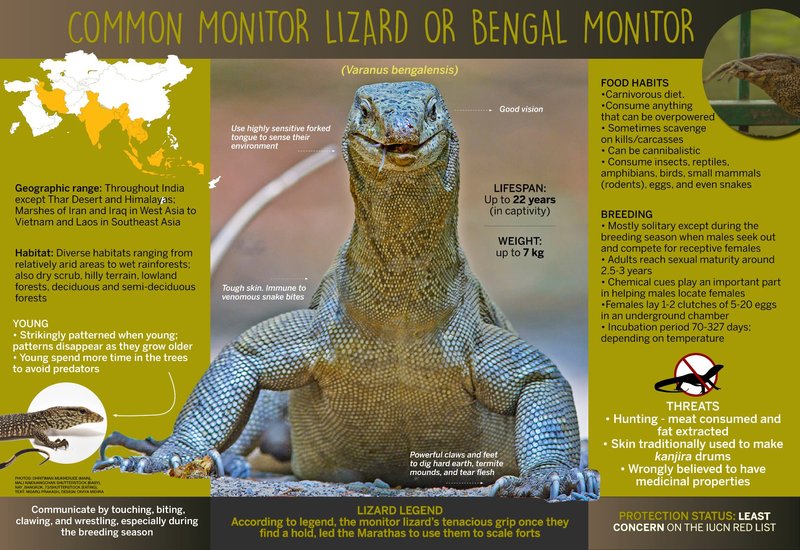
You might be wondering why it’s important to learn about monitor lizards or what makes them stand out. Well, like many creatures in our world, they’re surrounded by myths that often overshadow the facts. Today, let’s clear up some of those misconceptions and dive deep into what makes monitor lizards so special—from their habitats and behaviors to their diets and conservation status.
What Are Monitor Lizards?
Monitor lizards belong to the family Varanidae and include around 80 different species. They range in size from the small, roughly 20-inch-long spotted tree monitor to the massive Komodo dragon, which can exceed 10 feet in length. These lizards are known for their elongated snouts, long tails, and sharp claws, making them excellent hunters.
One of the most fascinating traits of monitor lizards is their incredible intelligence. They’re not just mindless reptiles; rather, they have been observed using tools and exhibiting complex behaviors like social interaction. Imagine a lizard that’s not just basking in the sun but is actively strategizing its next move!
Common Myths About Monitor Lizards
Myth 1: Monitor Lizards Are Dangerous to Humans
One of the biggest fears people have about monitor lizards is that they are aggressive and dangerous to humans. While it’s true that large species like the Komodo dragon can be hazardous, most monitor lizards are not a threat. They usually prefer to avoid humans and will only attack if they feel threatened.
Let’s look at it this way: Would you want to be cornered by a creature ten times your size? Of course not! Monitor lizards are generally shy and would rather retreat than confront a human.
Myth 2: They’re All the Same
Not all monitor lizards are created equal. From the medium-sized savannah monitor to the giant Komodo dragon, each species has its unique traits, habitats, and behaviors. Some are excellent swimmers, while others are tree-dwellers.
Imagine if someone said all dogs are the same. You wouldn’t compare a chihuahua to a Great Dane, right? The same applies to monitor lizards. Understanding their diversity is key to appreciating their beauty.
Where Do Monitor Lizards Live?
Monitor lizards can be found in various habitats all over Africa, Asia, and Australia. They’re often seen in tropical forests, savannas, and even deserts. Each species has adapted to its environment in fascinating ways.
For instance, the Asian water monitor is an exceptional swimmer, spending much of its time near water bodies, while the rock monitor thrives in rocky terrains. Their ability to adapt to diverse environments is one reason they’ve been successful across such a wide range.
What Do Monitor Lizards Eat?
Monitor lizards are carnivorous and have a varied diet consisting of insects, small mammals, birds, and even snakes. You might see them hunting actively, using their sharp claws and keen eyesight to catch prey.
Interestingly, some larger species, like the Komodo dragon, are known to engage in scavenging, feeding on carrion as well. It’s as if they embody the phrase “waste not, want not.” Their opportunistic feeding habits help them thrive in different conditions.
Monitor Lizard Behavior and Social Structure
Many people assume monitor lizards are solitary creatures, but that’s not entirely accurate. Some species can be surprisingly social and have been observed engaging in behaviors that suggest they form social bonds.
For example, they might bask together in the sun, sharing their space without aggression. This social aspect is often overlooked, and it adds another layer to their complex behavior, showing they’re more than just solitary predators.
Are Monitor Lizards Endangered?
The conservation status of monitor lizards varies by species. While some, like the Komodo dragon, are classified as vulnerable due to habitat loss and poaching, others are more stable.
Conservation efforts are crucial to protect these unique creatures. Imagine a world without them—there would be a significant gap in the ecosystem as they play vital roles in controlling prey populations and maintaining balance.
Promoting awareness and understanding can help ensure future generations can appreciate these fascinating lizards.
Monitor lizards are truly remarkable creatures, often misunderstood due to myths and misconceptions. By shedding light on the facts about their behavior, habitats, diets, and conservation needs, we can appreciate their role in our ecosystem.
Whether you’re a casual observer or an avid reptile enthusiast, understanding monitor lizards can deepen your connection to nature. They’re not just large lizards; they’re ancient survivors, fascinating in their complexity and adaptation. If we take the time to learn about them, we help ensure their continued existence and the health of our planet’s biodiversity.

